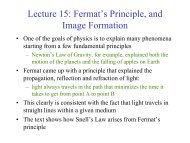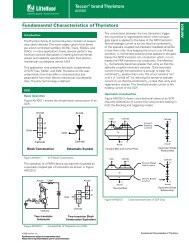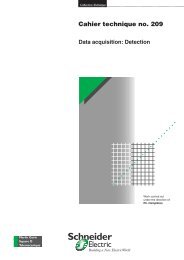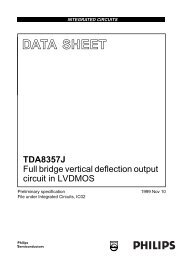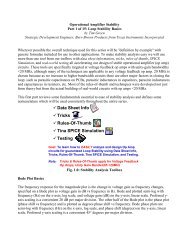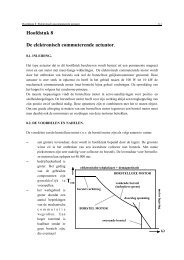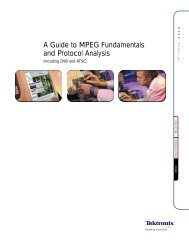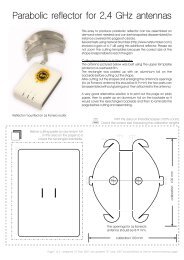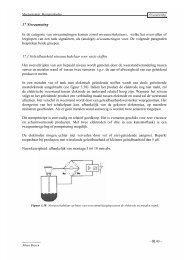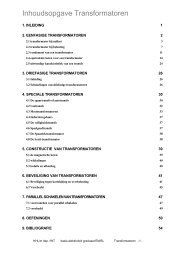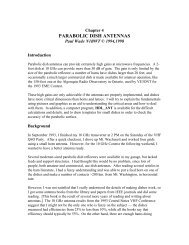VCR Brushless DC motor drive circuit - Educypedia
VCR Brushless DC motor drive circuit - Educypedia
VCR Brushless DC motor drive circuit - Educypedia
You also want an ePaper? Increase the reach of your titles
YUMPU automatically turns print PDFs into web optimized ePapers that Google loves.
DATA SHEET<br />
Product specification<br />
File under Integrated Circuits, IC11<br />
INTEGRATED CIRCUITS<br />
TDA5145TS<br />
<strong>Brushless</strong> <strong>DC</strong> <strong>motor</strong> <strong>drive</strong> <strong>circuit</strong><br />
1998 Oct 27
Philips Semiconductors Product specification<br />
<strong>Brushless</strong> <strong>DC</strong> <strong>motor</strong> <strong>drive</strong> <strong>circuit</strong> TDA5145TS<br />
FEATURES<br />
• Full-wave commutation (using push-pull <strong>drive</strong>rs at the<br />
output stages) without position sensors<br />
• Built-in start-up <strong>circuit</strong>ry<br />
• Three push-pull outputs:<br />
– Output current 2.0 A (typ.)<br />
– Built-in current limiter<br />
– Soft-switching outputs for low Electromagnetic<br />
Interference (EMI).<br />
• Thermal protection<br />
• Flyback diodes<br />
• Motor brake facility<br />
• Direction control input<br />
• Reset function.<br />
QUICK REFERENCE DATA<br />
Measured over full voltage and temperature range.<br />
Notes<br />
1. An unstabilized supply can be used.<br />
2. VVMOT =VP; all outputs Io = 0 mA.<br />
ORDERING INFORMATION<br />
1998 Oct 27 2<br />
APPLICATIONS<br />
• General purpose spindle <strong>drive</strong>r e.g.:<br />
– Hard disk <strong>drive</strong><br />
– Tape <strong>drive</strong><br />
– Optical disk <strong>drive</strong>.<br />
GENERAL DESCRIPTION<br />
The TDA5145TS is a bipolar integrated <strong>circuit</strong> used to<br />
<strong>drive</strong> 3-phase brushless <strong>DC</strong> <strong>motor</strong>s in full-wave mode.<br />
The device is sensorless (saving of 3 hall-sensors) using<br />
the back EMF sensing technique to sense the rotor<br />
position. It includes bidirectional control, brake function<br />
and has a special <strong>circuit</strong> built-in to reduce the EMI<br />
(soft-switching output stages).<br />
SYMBOL PARAMETER CONDITIONS MIN. TYP. MAX. UNIT<br />
VP supply voltage note 1 4 − 18 V<br />
Vi(VMOT) input voltage to the output <strong>drive</strong>r<br />
stages<br />
note 2 1.7 − 16 V<br />
VDO drop-out output voltage Io = 100 mA − 0.90 1.05 V<br />
ILIM current limiting VVMOT =10V; Ro= 1.2 Ω 1.8 2.0 2.5 A<br />
TYPE<br />
NUMBER<br />
PACKAGE<br />
NAME DESCRIPTION VERSION<br />
TDA5145TS SSOP24 plastic shrink small outline package; 24 leads;<br />
body width 5.3 mm<br />
SOT340-1
Philips Semiconductors Product specification<br />
<strong>Brushless</strong> <strong>DC</strong> <strong>motor</strong> <strong>drive</strong> <strong>circuit</strong> TDA5145TS<br />
BLOCK DIAGRAM<br />
handbook, full pagewidth<br />
CAP-ST<br />
CAP-<strong>DC</strong><br />
CAP-CD<br />
TEST<br />
CAP-TI<br />
DIR<br />
14<br />
13<br />
12<br />
3<br />
15<br />
9<br />
THERMAL<br />
PROTECTION<br />
TDA5145TS<br />
START-UP<br />
OSCILLATOR<br />
ADAPTIVE<br />
COMMUTATION<br />
DELAY<br />
TIMING<br />
DIRECTION<br />
CONTROL<br />
BRAKE<br />
BRAKE<br />
Fig.1 Block diagram.<br />
1998 Oct 27 3<br />
RESET<br />
VMOT<br />
8 18 6, 7<br />
RESET<br />
COMMUTATION<br />
LOGIC<br />
10 23, 24 11<br />
GND2<br />
GND1 V P<br />
D L<br />
D H<br />
PUSH/PULL<br />
FLYBACK<br />
OUTPUT<br />
DRIVER<br />
STAGE 1<br />
OUTPUT DRIVER<br />
STAGE 2<br />
OUTPUT DRIVER<br />
STAGE 3<br />
EMF COMPARATORS<br />
1, 2<br />
4, 5<br />
20,<br />
21<br />
22<br />
MGR391<br />
MOT1<br />
MOT2<br />
MOT3<br />
MOT0
Philips Semiconductors Product specification<br />
<strong>Brushless</strong> <strong>DC</strong> <strong>motor</strong> <strong>drive</strong> <strong>circuit</strong> TDA5145TS<br />
PINNING<br />
SYMBOL PIN DESCRIPTION<br />
MOT1 1 <strong>drive</strong>r output 1<br />
MOT1 2 <strong>drive</strong>r output 1<br />
TEST 3 test input/output<br />
MOT2 4 <strong>drive</strong>r output 2<br />
MOT2 5 <strong>drive</strong>r output 2<br />
VMOT 6 input voltage for the output <strong>drive</strong>r<br />
stages<br />
VMOT 7 input voltage for the output <strong>drive</strong>r<br />
stages<br />
BRAKE 8 brake input; this pin may not be left<br />
floating, a LOW-level voltage must<br />
be applied to disable this function<br />
DIR 9 direction control input; this pin may<br />
not be left floating<br />
GND2 10 ground supply return for control<br />
<strong>circuit</strong>s<br />
VP 11 supply voltage<br />
CAP-CD 12 external capacitor connection for<br />
adaptive communication delay<br />
timing<br />
CAP-<strong>DC</strong> 13 external capacitor connection for<br />
adaptive communication delay<br />
timing copy<br />
CAP-ST 14 external capacitor connection for<br />
start-up oscillator<br />
CAP-TI 15 external capacitor connection for<br />
timing<br />
n.c. 16 not connected<br />
n.c. 17 not connected<br />
RESET 18 reset input; this pin may not be left<br />
floating, a LOW-level voltage must<br />
be applied to disable this function<br />
n.c. 19 not connected<br />
MOT3 20 <strong>drive</strong>r output 3<br />
MOT3 21 <strong>drive</strong>r output 3<br />
MOT0 22 input from the star point of the <strong>motor</strong><br />
coils<br />
GND1 23 ground (0 V) <strong>motor</strong> supply return for<br />
output stages<br />
GND1 24 ground (0 V) <strong>motor</strong> supply return for<br />
output stages<br />
1998 Oct 27 4<br />
handbook, halfpage<br />
MOT1<br />
MOT1<br />
TEST<br />
MOT2<br />
MOT2<br />
VMOT<br />
VMOT<br />
BRAKE<br />
DIR<br />
GND2<br />
V P<br />
CAP-CD<br />
Fig.2 Pin configuration.<br />
FUNCTIONAL DESCRIPTION<br />
1<br />
2<br />
3<br />
4<br />
5<br />
6<br />
7<br />
8<br />
9<br />
10<br />
11<br />
12<br />
TDA5145TS<br />
MGR392<br />
GND1<br />
GND1<br />
MOT0<br />
MOT3<br />
MOT3<br />
The TDA5145TS offers a sensorless 3-phase <strong>motor</strong> <strong>drive</strong><br />
function. It is unique in its combination of sensorless <strong>motor</strong><br />
<strong>drive</strong> and full-wave <strong>drive</strong>. The TDA5145TS offers<br />
protected outputs capable of handling high currents and<br />
can be used with star or delta connected <strong>motor</strong>s. It can<br />
easily be adapted for different <strong>motor</strong>s and applications.<br />
The TDA5145TS offers the following features:<br />
• Sensorless commutation by using the <strong>motor</strong> EMF<br />
• Built-in start-up <strong>circuit</strong><br />
• Optimum commutation, independent of <strong>motor</strong> type or<br />
<strong>motor</strong> loading<br />
• Built-in flyback diodes<br />
• Three phase full-wave <strong>drive</strong><br />
• High output current (2.0 A)<br />
• Outputs protected by current limiting and thermal<br />
protection of each output transistor<br />
• Low current consumption by adaptive base-<strong>drive</strong><br />
• Soft-switching pulse output for low radiation<br />
• Direction of rotation controlled by one pin<br />
• Brake function.<br />
24<br />
23<br />
22<br />
21<br />
20<br />
19<br />
18<br />
17<br />
16<br />
15<br />
14<br />
13<br />
n.c.<br />
RESET<br />
n.c.<br />
n.c.<br />
CAP-TI<br />
CAP-ST<br />
CAP-<strong>DC</strong>
Philips Semiconductors Product specification<br />
<strong>Brushless</strong> <strong>DC</strong> <strong>motor</strong> <strong>drive</strong> <strong>circuit</strong> TDA5145TS<br />
LIMITING VALUES<br />
In accordance with the Absolute Maximum Rating System (IEC 134).<br />
SYMBOL PARAMETER CONDITIONS MIN. MAX. UNIT<br />
VP supply voltage − 18 V<br />
VI(n) input voltage; all pins except<br />
VMOT<br />
VI
Philips Semiconductors Product specification<br />
<strong>Brushless</strong> <strong>DC</strong> <strong>motor</strong> <strong>drive</strong> <strong>circuit</strong> TDA5145TS<br />
CHARACTERISTICS<br />
VP = 14.5 V; Tamb =25°C; unless otherwise specified.<br />
SYMBOL PARAMETER CONDITIONS MIN. TYP. MAX. UNIT<br />
Supply<br />
VP supply voltage note 1 4 − 18 V<br />
IP supply current note 2 − 6.8 7.8 mA<br />
Vi(VMOT) input voltage to the output <strong>drive</strong>r<br />
stages<br />
see Fig.1 1.7 − 16 V<br />
Thermal protection<br />
TSD local temperature at temperature<br />
sensor causing shut-down<br />
ΔT reduction in temperature before<br />
switch-on<br />
MOT0; centre tap<br />
1998 Oct 27 6<br />
130 140 150 °C<br />
after shut-down − TSD − 30 − K<br />
Vi input voltage −0.5 − VVMOT V<br />
Ibias input bias current 0.5 V < Vi
Philips Semiconductors Product specification<br />
<strong>Brushless</strong> <strong>DC</strong> <strong>motor</strong> <strong>drive</strong> <strong>circuit</strong> TDA5145TS<br />
SYMBOL PARAMETER CONDITIONS MIN. TYP. MAX. UNIT<br />
RESET<br />
VIH HIGH-level input voltage reset mode;<br />
4V
Philips Semiconductors Product specification<br />
<strong>Brushless</strong> <strong>DC</strong> <strong>motor</strong> <strong>drive</strong> <strong>circuit</strong> TDA5145TS<br />
Notes<br />
1. An unstabilized supply can be used.<br />
2. VVMOT =VP, all other inputs at 0 V; all outputs at VP; Io = 0 mA.<br />
3. Switching levels with respect to MOT1, MOT2 and MOT3.<br />
4. Drivers are in the high-impedance OFF-state.<br />
5. The outputs are short-<strong>circuit</strong> protected by limiting the current and the IC temperature.<br />
handbook, full pagewidth hysteresis 75 μV typ.<br />
MGR381<br />
back EMF signal<br />
V MOT0<br />
V CSW<br />
Fig.4 Switching levels with respect to MOT1, MOT2 and MOT3.<br />
1998 Oct 27 8<br />
V CSW<br />
handbook, halfpage 12.5 V<br />
12.5 V<br />
2.0 V<br />
t r<br />
2.0 V<br />
MGR382<br />
Fig.5 Output transition time measurement.<br />
t f<br />
MOT1, MOT2 and MOT3<br />
comparator threshold<br />
voltages
Philips Semiconductors Product specification<br />
<strong>Brushless</strong> <strong>DC</strong> <strong>motor</strong> <strong>drive</strong> <strong>circuit</strong> TDA5145TS<br />
APPLICATION INFORMATION<br />
handbook, full pagewidth<br />
GND1<br />
(1) Value selected for 3 Hz start-up oscillator frequency.<br />
Introduction (see Fig.7)<br />
Full-wave driving of a three phase <strong>motor</strong> requires three<br />
push-pull output stages. In each of the six possible states<br />
two outputs are active, one sourcing (H) and one sinking<br />
(L). The third output presents a high impedance (Z) to the<br />
<strong>motor</strong>, which enables measurement of the <strong>motor</strong> back<br />
EMF in the corresponding <strong>motor</strong> coil by the EMF<br />
comparator at each output. The commutation logic is<br />
responsible for control of the output transistors and<br />
selection of the correct EMF comparator. The sequence of<br />
the six possible states of the outputs is given in Table 1.<br />
The zero-crossing in the <strong>motor</strong> EMF (detected by the<br />
comparator selected by the commutation logic) is used to<br />
calculate the correct moment for the next commutation,<br />
that is, the change to the next output state. The delay is<br />
calculated (depending on the <strong>motor</strong> loading) by the<br />
adaptive commutation delay block.<br />
Because of high inductive loading the output stages<br />
contain flyback diodes. The output stages are also<br />
protected by a current limiting <strong>circuit</strong> and by thermal<br />
protection of the six output transistors.<br />
Fig.6 Application diagram.<br />
1998 Oct 27 9<br />
24<br />
220<br />
nF<br />
23 22 21 20 19 18 17 16 15 14 13<br />
TDA5145TS<br />
10 μF<br />
10<br />
nF<br />
1 2 3 4 5 6 7 8 9 10 11<br />
BRAKE DIR<br />
(1)<br />
VMOT V P<br />
Table 1 Output states; note 1<br />
12<br />
18 nF<br />
18 nF<br />
MGR393<br />
STATE MOT1 MOT2 MOT3<br />
1 Z L H<br />
2 H L Z<br />
3 H Z L<br />
4 Z H L<br />
5 L H Z<br />
6 L Z H<br />
Note<br />
1. H = HIGH state; L = LOW state; Z = high-impedance<br />
OFF-state.<br />
The system will only function when the EMF voltage from<br />
the <strong>motor</strong> is present. Therefore, a start oscillator is<br />
provided that will generate commutation pulses when no<br />
zero-crossings in the <strong>motor</strong> voltage are available.<br />
A timing function is incorporated into the device for internal<br />
timing and for timing of the reverse rotation detection.
Philips Semiconductors Product specification<br />
<strong>Brushless</strong> <strong>DC</strong> <strong>motor</strong> <strong>drive</strong> <strong>circuit</strong> TDA5145TS<br />
The TDA5145TS is designed for systems with low current<br />
consumption: use of I 2 L logic, adaptive base <strong>drive</strong> for the<br />
output transistors (patented).<br />
Adjustments<br />
The system has been designed in such a way that the<br />
tolerances of the application components are not critical.<br />
However, the approximate values of the following<br />
components must still be determined:<br />
• The start capacitor; this determines the frequency of the<br />
start oscillator.<br />
• The two capacitors in the adaptive commutation delay<br />
<strong>circuit</strong>; these are important in determining the optimum<br />
moment for commutation, depending on the type and<br />
loading of the <strong>motor</strong>.<br />
• The timing capacitor; this provides the system with its<br />
timing signals.<br />
THE START CAPACITOR (CAP-ST)<br />
This capacitor determines the frequency of the start<br />
oscillator. It is charged and discharged, with a current of<br />
2 μA, from 0.05 to 2.2 V and back to 0.05 V. The time<br />
taken to complete one cycle is given by:<br />
tstart = (2.15 × C) s (with C in μF)<br />
The start oscillator is reset by a commutation pulse and so<br />
is only active when the system is in the start-up mode.<br />
A pulse from the start oscillator will cause the outputs to<br />
change to the next state (torque in the <strong>motor</strong>). If the<br />
movement of the <strong>motor</strong> generates enough EMF the<br />
TDA5145TS will run the <strong>motor</strong>. If the amount of EMF<br />
generated is insufficient, then the <strong>motor</strong> will move one step<br />
only and will oscillate in its new position. The amplitude of<br />
the oscillation must decrease sufficiently before the arrival<br />
of the next start pulse, to prevent the pulse arriving during<br />
the wrong phase of the oscillation. The oscillation of the<br />
<strong>motor</strong> is given by:<br />
f osc<br />
where:<br />
1<br />
2π K = ---------------------------------t<br />
× I × p<br />
----------------------<br />
J<br />
Kt = torque constant (N.m/A)<br />
I = current (A)<br />
p = number of magnetic pole-pairs<br />
J = inertia J (kg.m2 )<br />
Example: J = 72 × 10 −6 kg.m 2 , Kt =25×10 −3 N.m/A, p = 6<br />
and I = 0.5 A; this gives fosc = 5 Hz.<br />
1998 Oct 27 10<br />
If the damping is high then a start frequency of 2 Hz can be<br />
chosen or t = 500 ms, thus C = 0.5/2 = 0.25 μF<br />
(choose 220 nF).<br />
THE ADAPTIVE COMMUTATION DELAY (CAP-CD AND<br />
CAP-<strong>DC</strong>)<br />
In this <strong>circuit</strong>, capacitor CAP-CD is charged during one<br />
commutation period, with an interruption of the charging<br />
current during the diode pulse. During the next<br />
commutation period this capacitor (CAP-CD) is discharged<br />
at twice the charging current. The charging current is<br />
8.1 μA and the discharging current 16.2 μA; the voltage<br />
range is from 0.9 to 2.2 V. The voltage must stay within<br />
this range at the lowest commutation frequency of<br />
interest, fC1:<br />
C<br />
8.1 10 6 –<br />
×<br />
= ------------------------- =<br />
f × 1.3<br />
6231<br />
-----------fC1<br />
(C in nF)<br />
If the frequency is lower, then a constant commutation<br />
delay after the zero-crossing is generated by the discharge<br />
from 2.2 to 0.9 V at 16.2 μA; maximum<br />
delay = (0.076 × C) ms (with C in nF)<br />
Example: nominal commutation frequency = 900 Hz and<br />
the lowest usable frequency = 400 Hz; thus:<br />
6231<br />
CAP-CD = ------------ =<br />
15.6<br />
400<br />
(choose 18 nF)<br />
The other capacitor, CAP-<strong>DC</strong>, is used to repeat the same<br />
delay by charging and discharging with 15.5 μA. The same<br />
value can be chosen as for CAP-CD. Figure 8 illustrates<br />
typical voltage waveforms.
Philips Semiconductors Product specification<br />
<strong>Brushless</strong> <strong>DC</strong> <strong>motor</strong> <strong>drive</strong> <strong>circuit</strong> TDA5145TS<br />
handbook, full pagewidth<br />
220 nF<br />
18 nF<br />
18 nF<br />
TEST<br />
10 nF<br />
V P<br />
GND2<br />
GND1<br />
14<br />
13<br />
12<br />
3<br />
15<br />
10<br />
11<br />
THERMAL<br />
PROTECTION<br />
TDA5145TS<br />
START-UP<br />
OSCILLATOR<br />
ADAPTIVE<br />
COMMUNICATION<br />
DELAY<br />
TIMING<br />
DIRECTION<br />
CONTROL<br />
Fig.7 Typical application of the TDA5145TS as a scanner <strong>drive</strong>r.<br />
1998 Oct 27 11<br />
9<br />
DIR<br />
BRAKE RESET VMOT<br />
8<br />
BRAKE<br />
RESET<br />
COMMUNICATION<br />
LOGIC<br />
18 6, 7 23, 24<br />
TP<br />
TP<br />
TP<br />
TN<br />
TN<br />
TN<br />
TN<br />
TN<br />
TN<br />
EMF<br />
COMPARATORS<br />
D<br />
D<br />
D<br />
D<br />
D<br />
D<br />
1, 2<br />
4, 5<br />
20, 21<br />
22<br />
MGR394<br />
MOTOR
Philips Semiconductors Product specification<br />
<strong>Brushless</strong> <strong>DC</strong> <strong>motor</strong> <strong>drive</strong> <strong>circuit</strong> TDA5145TS<br />
handbook, full pagewidth<br />
voltage<br />
on CAP-CD<br />
voltage<br />
on CAP-<strong>DC</strong><br />
THE TIMING CAPACITOR (CAP-TI)<br />
Fig.8 CAP-CD and CAP-<strong>DC</strong> typical voltage waveforms in normal running mode.<br />
Capacitor CAP-TI is used for timing the successive steps<br />
within one commutation period; these steps include some<br />
internal delays.<br />
The most important function is the watchdog time in which<br />
the <strong>motor</strong> EMF has to recover from a negative diode pulse<br />
back to a positive EMF voltage (or vice versa). A watchdog<br />
timer is a guarding function that only becomes active when<br />
the expected event does not occur within a predetermined<br />
time.<br />
The EMF usually recovers within a short time if the <strong>motor</strong><br />
is running normally (ms).<br />
A watchdog time must be chosen so that it is long enough<br />
for a <strong>motor</strong> without EMF (still) and eddy currents that may<br />
stretch the voltage in a <strong>motor</strong> winding; however, it must be<br />
short enough to detect reverse rotation. If the watchdog<br />
time is made too long, then the <strong>motor</strong> may run in the wrong<br />
direction (with little torque).<br />
1998 Oct 27 12<br />
t<br />
MGH317<br />
The capacitor is charged with a current of 57 μA, from<br />
0.2 to 0.3 V. Above this level it is charged with a current of<br />
5 μA, up to 2.2 V only if the selected <strong>motor</strong> EMF remains<br />
in the wrong polarity (watchdog function). At the end, or, if<br />
the <strong>motor</strong> voltage becomes positive, the capacitor is<br />
discharged with a current of 28 μA. The watchdog time is<br />
the time taken to charge the capacitor with a current of<br />
5 μA, from 0.3 to 2.2 V.<br />
To ensure that the internal delays are covered CAP-TI<br />
must have a minimum value of 2 nF. For the watchdog<br />
function a value of 10 nF for CAP-TI is recommended.<br />
To ensure a good start-up and commutation, care must be<br />
taken that no oscillations occur at the trailing edge of the<br />
flyback pulse. Snubber networks at the outputs should be<br />
critically damped.<br />
Typical voltage waveforms are illustrated in Fig.9.
Philips Semiconductors Product specification<br />
<strong>Brushless</strong> <strong>DC</strong> <strong>motor</strong> <strong>drive</strong> <strong>circuit</strong> TDA5145TS<br />
handbook, full pagewidth<br />
V MOT 1<br />
voltage<br />
on CAP-TI<br />
If the chosen value of CAP-TI is too small oscillations can occur in certain positions of a blocked rotor. If the chosen value is too large, then it is possible<br />
that the <strong>motor</strong> may run in the reverse direction (synchronously with little torque).<br />
Other design aspects<br />
Fig.9 Typical CAP-TI and VMOT1 voltage waveforms in normal running mode.<br />
There are other design aspects concerning the application<br />
of the TDA5145TS besides the commutation function.<br />
They are:<br />
• Direction function<br />
• Brake function<br />
• Reliability.<br />
DIRECTION FUNCTION<br />
If the voltage at pin 9 is less than 0.8 V, the <strong>motor</strong> is<br />
running in one direction (depending on the <strong>motor</strong><br />
connections). If the voltage at pin 9 is greater than 2.0 V,<br />
the <strong>motor</strong> is running in the opposite direction.<br />
BRAKE FUNCTION<br />
If the voltage at pin 8 is greater than 2.0 V, the <strong>motor</strong><br />
brakes. In that condition, the 3 outputs MOT1, MOT2 and<br />
MOT3 are forced to a LOW voltage level and the current<br />
limitation is performed internally by the sink <strong>drive</strong>rs.<br />
1998 Oct 27 13<br />
RESET FUNCTION<br />
MGH318<br />
If the voltage at pin 18 is greater than 2.0 V, the output<br />
states are shown in Table 2.<br />
Table 2 Output states if VRESET > 2.0 V<br />
DRIVER OUTPUT STATE (1)<br />
MOT1 Z<br />
MOT2 L<br />
MOT3 H<br />
Note<br />
1. Z = high-impedance OFF-state; L = LOW state;<br />
H = HIGH state.
Philips Semiconductors Product specification<br />
<strong>Brushless</strong> <strong>DC</strong> <strong>motor</strong> <strong>drive</strong> <strong>circuit</strong> TDA5145TS<br />
Table 3 Switching sequence after a reset pulse; note 1<br />
DIR RESET MOT1 MOT2 DIR FUNCTION<br />
H H Z L H reset<br />
H L Z L H normal direction<br />
H L H L Z mode sequence<br />
H L H Z L<br />
H L Z H L<br />
H L L H Z<br />
H L L Z H<br />
L H H L Z reset<br />
L L H L Z reverse direction<br />
L L Z L H mode sequence<br />
L L L Z H<br />
L L L H Z<br />
L L Z H L<br />
L L H Z L<br />
Note<br />
1. Z = high-impedance OFF-state; L = LOW state; H = HIGH state.<br />
Table 4 Priority of function; note 1<br />
BRAKE TEST RESET FUNCTION<br />
L L L normal<br />
L L H reset<br />
L H L test<br />
L H H test<br />
H L L brake<br />
H L H brake<br />
H H L brake<br />
H H H brake<br />
Note<br />
1. L = LOW state; H = HIGH state.<br />
RELIABILITY<br />
It is necessary to protect high current <strong>circuit</strong>s and the output stages are protected in two ways:<br />
• Current limiting of the ‘lower’ output transistors. The ‘upper’ output transistors use the same base current as the<br />
conducting ‘lower’ transistor (+15%). This means that the current to and from the output stages is limited.<br />
• Thermal protection of the six output transistors is achieved by each transistor having a thermal sensor that is active<br />
when the transistor is switched on. The transistors are switched off when the ambient temperature becomes too high.<br />
1998 Oct 27 14
Philips Semiconductors Product specification<br />
<strong>Brushless</strong> <strong>DC</strong> <strong>motor</strong> <strong>drive</strong> <strong>circuit</strong> TDA5145TS<br />
PACKAGE OUTLINE<br />
SSOP24: plastic shrink small outline package; 24 leads; body width 5.3 mm SOT340-1<br />
DIMENSIONS (mm are the original dimensions)<br />
UNIT A1 A2 A3 bp c D (1) A<br />
max.<br />
E (1) e HE L Lp Q v w y Z(1)<br />
θ<br />
mm 2.0<br />
0.21<br />
0.05<br />
1.80<br />
1.65<br />
0.25<br />
0.38<br />
0.25<br />
0.20<br />
0.09<br />
8.4<br />
8.0<br />
5.4<br />
5.2<br />
0.65<br />
7.9<br />
7.6<br />
1.25<br />
1.03<br />
0.63<br />
0.9<br />
0.7<br />
0.2 0.13 0.1<br />
0.8<br />
0.4<br />
o<br />
8<br />
o<br />
0<br />
Note<br />
1. Plastic or metal protrusions of 0.20 mm maximum per side are not included.<br />
OUTLINE<br />
VERSION<br />
Z<br />
y<br />
REFERENCES<br />
IEC JEDEC EIAJ<br />
SOT340-1 MO-150AG<br />
w M<br />
1998 Oct 27 15<br />
D<br />
24 13<br />
pin 1 index<br />
1 12<br />
e<br />
bp<br />
A2<br />
A1<br />
0 2.5<br />
scale<br />
5 mm<br />
c<br />
E<br />
HE<br />
L<br />
detail X<br />
L p<br />
Q<br />
(A )<br />
3<br />
EUROPEAN<br />
PROJECTION<br />
A<br />
θ<br />
A<br />
X<br />
v M A<br />
ISSUE DATE<br />
93-09-08<br />
95-02-04
Philips Semiconductors Product specification<br />
<strong>Brushless</strong> <strong>DC</strong> <strong>motor</strong> <strong>drive</strong> <strong>circuit</strong> TDA5145TS<br />
SOLDERING<br />
Introduction<br />
There is no soldering method that is ideal for all IC<br />
packages. Wave soldering is often preferred when<br />
through-hole and surface mounted components are mixed<br />
on one printed-<strong>circuit</strong> board. However, wave soldering is<br />
not always suitable for surface mounted ICs, or for<br />
printed-<strong>circuit</strong>s with high population densities. In these<br />
situations reflow soldering is often used.<br />
This text gives a very brief insight to a complex technology.<br />
A more in-depth account of soldering ICs can be found in<br />
our “Data Handbook IC26; Integrated Circuit Packages”<br />
(order code 9398 652 90011).<br />
Reflow soldering<br />
Reflow soldering techniques are suitable for all SSOP<br />
packages.<br />
Reflow soldering requires solder paste (a suspension of<br />
fine solder particles, flux and binding agent) to be applied<br />
to the printed-<strong>circuit</strong> board by screen printing, stencilling or<br />
pressure-syringe dispensing before package placement.<br />
Several techniques exist for reflowing; for example,<br />
thermal conduction by heated belt. Dwell times vary<br />
between 50 and 300 seconds depending on heating<br />
method. Typical reflow temperatures range from<br />
215 to 250 °C.<br />
Preheating is necessary to dry the paste and evaporate<br />
the binding agent. Preheating duration: 45 minutes at<br />
45 °C.<br />
Wave soldering<br />
Wave soldering is not recommended for SSOP packages.<br />
This is because of the likelihood of solder bridging due to<br />
closely-spaced leads and the possibility of incomplete<br />
solder penetration in multi-lead devices.<br />
1998 Oct 27 16<br />
If wave soldering cannot be avoided, the following<br />
conditions must be observed:<br />
• A double-wave (a turbulent wave with high upward<br />
pressure followed by a smooth laminar wave)<br />
soldering technique should be used.<br />
• The longitudinal axis of the package footprint must<br />
be parallel to the solder flow and must incorporate<br />
solder thieves at the downstream end.<br />
Even with these conditions, only consider wave<br />
soldering SSOP packages that have a body width of<br />
4.4 mm, that is SSOP16 (SOT369-1) or<br />
SSOP20 (SOT266-1).<br />
During placement and before soldering, the package must<br />
be fixed with a droplet of adhesive. The adhesive can be<br />
applied by screen printing, pin transfer or syringe<br />
dispensing. The package can be soldered after the<br />
adhesive is cured.<br />
Maximum permissible solder temperature is 260 °C, and<br />
maximum duration of package immersion in solder is<br />
10 seconds, if cooled to less than 150 °C within<br />
6 seconds. Typical dwell time is 4 seconds at 250 °C.<br />
A mildly-activated flux will eliminate the need for removal<br />
of corrosive residues in most applications.<br />
Repairing soldered joints<br />
Fix the component by first soldering two diagonallyopposite<br />
end leads. Use only a low voltage soldering iron<br />
(less than 24 V) applied to the flat part of the lead. Contact<br />
time must be limited to 10 seconds at up to 300 °C. When<br />
using a dedicated tool, all other leads can be soldered in<br />
one operation within 2 to 5 seconds between<br />
270 and 320 °C.
Philips Semiconductors Product specification<br />
<strong>Brushless</strong> <strong>DC</strong> <strong>motor</strong> <strong>drive</strong> <strong>circuit</strong> TDA5145TS<br />
DEFINITIONS<br />
Data sheet status<br />
Objective specification This data sheet contains target or goal specifications for product development.<br />
Preliminary specification This data sheet contains preliminary data; supplementary data may be published later.<br />
Product specification This data sheet contains final product specifications.<br />
Limiting values<br />
Limiting values given are in accordance with the Absolute Maximum Rating System (IEC 134). Stress above one or<br />
more of the limiting values may cause permanent damage to the device. These are stress ratings only and operation<br />
of the device at these or at any other conditions above those given in the Characteristics sections of the specification<br />
is not implied. Exposure to limiting values for extended periods may affect device reliability.<br />
Application information<br />
Where application information is given, it is advisory and does not form part of the specification.<br />
LIFE SUPPORT APPLICATIONS<br />
These products are not designed for use in life support appliances, devices, or systems where malfunction of these<br />
products can reasonably be expected to result in personal injury. Philips customers using or selling these products for<br />
use in such applications do so at their own risk and agree to fully indemnify Philips for any damages resulting from such<br />
improper use or sale.<br />
1998 Oct 27 17
Philips Semiconductors Product specification<br />
<strong>Brushless</strong> <strong>DC</strong> <strong>motor</strong> <strong>drive</strong> <strong>circuit</strong> TDA5145TS<br />
NOTES<br />
1998 Oct 27 18
Philips Semiconductors Product specification<br />
<strong>Brushless</strong> <strong>DC</strong> <strong>motor</strong> <strong>drive</strong> <strong>circuit</strong> TDA5145TS<br />
NOTES<br />
1998 Oct 27 19
Philips Semiconductors – a worldwide company<br />
Argentina: see South America<br />
Australia: 34 Waterloo Road, NORTH RYDE, NSW 2113,<br />
Tel. +61 2 9805 4455, Fax. +61 2 9805 4466<br />
Austria: Computerstr. 6, A-1101 WIEN, P.O. Box 213, Tel. +43 160 1010,<br />
Fax. +43 160 101 1210<br />
Belarus: Hotel Minsk Business Center, Bld. 3, r. 1211, Volodarski Str. 6,<br />
220050 MINSK, Tel. +375 172 200 733, Fax. +375 172 200 773<br />
Belgium: see The Netherlands<br />
Brazil: see South America<br />
Bulgaria: Philips Bulgaria Ltd., Energoproject, 15th floor,<br />
51 James Bourchier Blvd., 1407 SOFIA,<br />
Tel. +359 2 689 211, Fax. +359 2 689 102<br />
Canada: PHILIPS SEMICONDUCTORS/COMPONENTS,<br />
Tel. +1 800 234 7381<br />
China/Hong Kong: 501 Hong Kong Industrial Technology Centre,<br />
72 Tat Chee Avenue, Kowloon Tong, HONG KONG,<br />
Tel. +852 2319 7888, Fax. +852 2319 7700<br />
Colombia: see South America<br />
Czech Republic: see Austria<br />
Denmark: Prags Boulevard 80, PB 1919, DK-2300 COPENHAGEN S,<br />
Tel. +45 32 88 2636, Fax. +45 31 57 0044<br />
Finland: Sinikalliontie 3, FIN-02630 ESPOO,<br />
Tel. +358 9 615800, Fax. +358 9 61580920<br />
France: 51 Rue Carnot, BP317, 92156 SURESNES Cedex,<br />
Tel. +33 1 40 99 6161, Fax. +33 1 40 99 6427<br />
Germany: Hammerbrookstraße 69, D-20097 HAMBURG,<br />
Tel. +49 40 23 53 60, Fax. +49 40 23 536 300<br />
Greece: No. 15, 25th March Street, GR 17778 TAVROS/ATHENS,<br />
Tel. +30 1 4894 339/239, Fax. +30 1 4814 240<br />
Hungary: see Austria<br />
India: Philips INDIA Ltd, Band Box Building, 2nd floor,<br />
254-D, Dr. Annie Besant Road, Worli, MUMBAI 400 025,<br />
Tel. +91 22 493 8541, Fax. +91 22 493 0966<br />
Indonesia: PT Philips Development Corporation, Semiconductors Division,<br />
Gedung Philips, Jl. Buncit Raya Kav.99-100, JAKARTA 12510,<br />
Tel. +62 21 794 0040 ext. 2501, Fax. +62 21 794 0080<br />
Ireland: Newstead, Clonskeagh, DUBLIN 14,<br />
Tel. +353 1 7640 000, Fax. +353 1 7640 200<br />
Israel: RAPAC Electronics, 7 Kehilat Saloniki St, PO Box 18053,<br />
TEL AVIV 61180, Tel. +972 3 645 0444, Fax. +972 3 649 1007<br />
Italy: PHILIPS SEMICONDUCTORS, Piazza IV Novembre 3,<br />
20124 MILANO, Tel. +39 2 6752 2531, Fax. +39 2 6752 2557<br />
Japan: Philips Bldg 13-37, Kohnan 2-chome, Minato-ku,<br />
TOKYO 108-8507, Tel. +81 3 3740 5130, Fax. +81 3 3740 5077<br />
Korea: Philips House, 260-199 Itaewon-dong, Yongsan-ku, SEOUL,<br />
Tel. +82 2 709 1412, Fax. +82 2 709 1415<br />
Malaysia: No. 76 Jalan Universiti, 46200 PETALING JAYA, SELANGOR,<br />
Tel. +60 3 750 5214, Fax. +60 3 757 4880<br />
Mexico: 5900 Gateway East, Suite 200, EL PASO, TEXAS 79905,<br />
Tel. +9-5 800 234 7381<br />
For all other countries apply to: Philips Semiconductors,<br />
International Marketing & Sales Communications, Building BE-p, P.O. Box 218,<br />
5600 MD EINDHOVEN, The Netherlands, Fax. +31 40 27 24825<br />
Middle East: see Italy<br />
Netherlands: Postbus 90050, 5600 PB EINDHOVEN, Bldg. VB,<br />
Tel. +31 40 27 82785, Fax. +31 40 27 88399<br />
New Zealand: 2 Wagener Place, C.P.O. Box 1041, AUCKLAND,<br />
Tel. +64 9 849 4160, Fax. +64 9 849 7811<br />
Norway: Box 1, Manglerud 0612, OSLO,<br />
Tel. +47 22 74 8000, Fax. +47 22 74 8341<br />
Pakistan: see Singapore<br />
Philippines: Philips Semiconductors Philippines Inc.,<br />
106 Valero St. Salcedo Village, P.O. Box 2108 MCC, MAKATI,<br />
Metro MANILA, Tel. +63 2 816 6380, Fax. +63 2 817 3474<br />
Poland: Ul. Lukiska 10, PL 04-123 WARSZAWA,<br />
Tel. +48 22 612 2831, Fax. +48 22 612 2327<br />
Portugal: see Spain<br />
Romania: see Italy<br />
Russia: Philips Russia, Ul. Usatcheva 35A, 119048 MOSCOW,<br />
Tel. +7 095 755 6918, Fax. +7 095 755 6919<br />
Singapore: Lorong 1, Toa Payoh, SINGAPORE 319762,<br />
Tel. +65 350 2538, Fax. +65 251 6500<br />
Slovakia: see Austria<br />
Slovenia: see Italy<br />
South Africa: S.A. PHILIPS Pty Ltd., 195-215 Main Road Martindale,<br />
2092 JOHANNESBURG, P.O. Box 7430 Johannesburg 2000,<br />
Tel. +27 11 470 5911, Fax. +27 11 470 5494<br />
South America: Al. Vicente Pinzon, 173, 6th floor,<br />
04547-130 SÃO PAULO, SP, Brazil,<br />
Tel. +55 11 821 2333, Fax. +55 11 821 2382<br />
Spain: Balmes 22, 08007 BARCELONA,<br />
Tel. +34 93 301 6312, Fax. +34 93 301 4107<br />
Sweden: Kottbygatan 7, Akalla, S-16485 STOCKHOLM,<br />
Tel. +46 8 5985 2000, Fax. +46 8 5985 2745<br />
Switzerland: Allmendstrasse 140, CH-8027 ZÜRICH,<br />
Tel. +41 1 488 2741 Fax. +41 1 488 3263<br />
Taiwan: Philips Semiconductors, 6F, No. 96, Chien Kuo N. Rd., Sec. 1,<br />
TAIPEI, Taiwan Tel. +886 2 2134 2865, Fax. +886 2 2134 2874<br />
Thailand: PHILIPS ELECTRONICS (THAILAND) Ltd.,<br />
209/2 Sanpavuth-Bangna Road Prakanong, BANGKOK 10260,<br />
Tel. +66 2 745 4090, Fax. +66 2 398 0793<br />
Turkey: Talatpasa Cad. No. 5, 80640 GÜLTEPE/ISTANBUL,<br />
Tel. +90 212 279 2770, Fax. +90 212 282 6707<br />
Ukraine: PHILIPS UKRAINE, 4 Patrice Lumumba str., Building B, Floor 7,<br />
252042 KIEV, Tel. +380 44 264 2776, Fax. +380 44 268 0461<br />
United Kingdom: Philips Semiconductors Ltd., 276 Bath Road, Hayes,<br />
MIDDLESEX UB3 5BX, Tel. +44 181 730 5000, Fax. +44 181 754 8421<br />
United States: 811 East Arques Avenue, SUNNYVALE, CA 94088-3409,<br />
Tel. +1 800 234 7381<br />
Uruguay: see South America<br />
Vietnam: see Singapore<br />
Yugoslavia: PHILIPS, Trg N. Pasica 5/v, 11000 BEOGRAD,<br />
Tel. +381 11 625 344, Fax.+381 11 635 777<br />
Internet: http://www.semiconductors.philips.com<br />
© Philips Electronics N.V. 1998<br />
All rights are reserved. Reproduction in whole or in part is prohibited without the prior written consent of the copyright owner.<br />
SCA60<br />
The information presented in this document does not form part of any quotation or contract, is believed to be accurate and reliable and may be changed<br />
without notice. No liability will be accepted by the publisher for any consequence of its use. Publication thereof does not convey nor imply any license<br />
under patent- or other industrial or intellectual property rights.<br />
Printed in The Netherlands 295102/750/01/pp20 Date of release: 1998 Oct 27 Document order number: 9397 750 04042



